From Splurge Taos.
Check it out. A limited number of these certificates, so act now!
From Splurge Taos.
Check it out. A limited number of these certificates, so act now!
Jennie Iverson has just published her first cookbook, Ski Town Soups: Signature Soups from World Class Ski Resorts. I’m pleased that Taos Ski Valley is represented in this beautiful book — The Blonde Bear Tavern contributed two recipes, and The Bavarian shared the recipe for its famous Bavarian goulash (featured on the book’s cover).

Jennie is a wife and a mother of two boys; she tells how her family savors days on the mountain. Not only does she love the snow, but she has a general adoration of winter. She’s enthusiastic about making soups, stews and chilies in cold weather, and relishes a cup or bowl in front of the fire with her family.
Over the past three years she embarked on a journey to hunt down the best soups as she traveled to Sun Valley, Jackson Hole, Mt. Bachelor, Mt. Hood, Whitefish Mountain., Big Sky, Moonlight Basin, Heavenly, Northstar-at-Tahoe, Park City, Vail, and Beaver Creek. What grew from these travel experiences was what she describes as a perfectly balanced recipe for life: a ski town, a comfortable restaurant, and a yummy bowl of soup. As she likes to say: “Although soup is typically meant to simmer, life is meant to boil!”
The Ski Town Soups cookbook is a must-have souvenir for skiers and foodies alike. The book is a beautiful, colorful rendition of 60 North American ski resorts, restaurant dining rooms, renowned chefs, and over 100 unique soup recipes with ultimate regional flare.
I’ve had a chance to preview this cookbook before it’s available to the public and I’m happy to recommend it to anyone who loves soups, chowders, bisques, and chilies. The recipes are conveniently categorized in these sections. Each recipe is rated with a “difficulty level” from “easiest” to “most difficult”. The recipes were shared by some of the best chefs in North America’s mountain resorts and features beautiful photographs not only of the delicious dishes, but of the continent’s most beautiful mountain getaways.
The book’s foreword is provided by Kelly Liken, who, along with her husband, owns Restaurant Kelly Liken in Vail, Colorado. She begins by saying, “It has been said that the mark of a great chef can be found in their creation of a great soup.”
You can order the book from Amazon by clicking here. For a preview, check out Jennie’s blog at www.skitownsoups.com.
.
Oktoberfrest is a 16-day festival held each year in Munich, Bavaria, Germany. It runs from late September to the first weekend in October. Oktoberfest is one of Germany’s most famous events and is considered the world’s largest fair, with more than 5 million people attending every year. Countless communities across the world also celebrate this beer festival, and Taos Ski Valley is no exception! Our celebration is Saturday, September 15th.
.
History of Oktoberfest
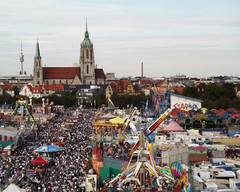
Crown Prince Ludwig, who later became King, married Princess Terese of Saxe-Hildburghausen on October 12, 1810. Everyone in Munich was invited to the festivities held on the fields at the city gates. The fields were named Theresienwiese (“Theresa’s Meadow”) in honor of the Princess. The locals refer to the field as Wies’n.
Horse races in the presence of the Royal Family marked the event’s closing that was celebrated as a festival for the whole of Bavaria. The decision to repeat the horse races in the subsequent year gave rise to the tradition of the Oktoberfest.
.
Two Classic Dishes
Along with the ubiquitous bratwurst, pretzels, and (of course) beer, there are two other dishes that abound during Oktoberfest season: Obatzda (cheese and beer dip on rye bread) and Datschi (fruit-topped cake).
I turned to The Blonde Bear Tavern’s Consulting Chef, Andreas Dirnagl, for these classic recipes (klassischen Rezepten). Andreas’s parents (pictured above) are Bavarian natives, who moved to the United States shortly after their 1957 marriage.
.
Obatzda
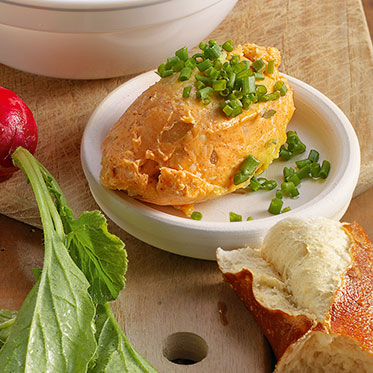
Chef Andreas gives us background:
A Bavarian specialty in the beer gardens, Obatzda is really more of a spread than a dip. Use a good hearty rye or dark bread (sliced works best). Place a slice of bread on a plate with a scoop of the spread on top. Garnish with onion, chive, and paprika. You can also serve radishes with salt and butter on the side. Yum!
.
Ingredients:
Preparing Obatzda
Note: For a more authentic texture, set aside about 1/3 of the Camembert in a small dice and then fold it into the finished product. You may also use a bit of the rind.
.
Datschi
Datschi (pronounced dah-chi) is a Bavarian word that means any of a variety of fruit-topped cake. Again, Chef Andreas gives us background:
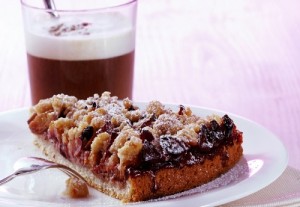
Commonality is that the dough is pressed into a straight sided pan (Datschi comes from the verb detschen, which means “to smoosh”). There is no rim built up on the edges of the dough, and it is topped with some form of fresh fruit. Streusel topping is optional. The dessert is served simply on a small plate, usually topped with a dollop of whipped cream.
These cakes are a mainstay of every Bavarian bakery and major open air festival, as they can be made in big sheets. Fruit topping is variable, although plum is the most common. If you want authenticity, you need Italian plums. Remember in baking – if it eats sour, it bakes sweet and vice versa. Italian plums look kind of like plum tomatoes (as opposed to regular plums, which are round) and are quite sour if you eat them raw. When you bake them they become sweet / sour.
This recipe is from my mom, Inge, and is quite common in the Bavarian neighborhood where she grew up:
.
Ingredients:
For the Cake
For the Optional Streusel
.
Preparing Datschi
.
For optional streusel:
.
Variations:
If using apples, use a tart variety. Peel, core, and slice into about 1/2″ wedges. You can also use about a 1/4 inch layer of apricot or raspberry jam or jelly if you have no fruit on hand. If using jam or jelly topping, then streusel is no longer optional – rather double the streusel recipe and completely cover the jam/ jelly topping with streusel before baking.
.
Oktoberfest at Taos Ski Valley
This year looks to be the biggest and best Oktoberfest in Taos Ski Valley. And it’s FREE fun for all ages.
The day will feature an authentic Schuplatter band and dancers, German beer and food, activities for kids, Brat eating contest, Yodeling contest, Alpenhorn blowing contests, and more.
Our Village stores will be offering pre-season blowout prices on ski gear and sporting apparel.
.
*A Note about the Black and White Photo Above:
At my request, Andreas sent me an Oktoberfest picture with his mom (whose Datschi recipe she graciously shared) and dad (who is now deceased). He sent the following accompanying message, which I think bears repeating:
The year was 1957 and Mom was 28. This is Oktoberfest as it used to be. Mom is on the left with my dad immediately behind her. They would have been married all of 4 months at this point. Behind my dad is my grandfather (mom’s dad). The woman on the right is my Aunt Maria and the man with his arm around her shoulder is her husband, my Uncle Siegried (my dad’s brother). The other man is a stranger who photo bombed the picture.
Mom says that she and my Aunt went for a walk to see the sights at Oktoberfest and the men stayed back in the tent to save the seats. By the time they got back, the men were ripped and as she passed by to sit down my uncle grabbed her beret and wore it for the picture.
.
At Bellavitae in New York, we enjoyed serving the many celebrities who dined with us. As I wrote when we closed, “I’ve never been star struck, but it was always fun to have famous people in the restaurant, many of whom became regulars.”
Here in northern New Mexico, we dine with different kinds of stars – thousands of them twinkling above in the heavens. At an altitude of nearly 10,000 feet, the dry Southwest sky is virtually free of humidity, dust, and manmade pollutants, enabling brilliant stars to penetrate the velvet darkness above.
This summer, The Blonde Bear Tavern will be serving a gourmet dinner on a moonless night to celebrate the stars: August 11th at 7:00 pm. Joining us will be Geoff Goins and Night Sky Adventures, who will show us the night’s universe, in real time, with our own eyes. After dessert, we’ll explore the night sky through one of the largest telescopes in New Mexico – with one of the best astronomy guides in the country.
.
The Menu
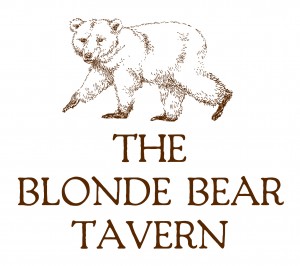 The prix fixe menu is Piedmont-inspired – an Italian region also known for its spectacular Alpine night skies. And the dates correspond with Taos Ski Valley’s local chanterelle season – so if Mother Nature cooperates, these fabulous mushrooms will be a part of the menu.
The prix fixe menu is Piedmont-inspired – an Italian region also known for its spectacular Alpine night skies. And the dates correspond with Taos Ski Valley’s local chanterelle season – so if Mother Nature cooperates, these fabulous mushrooms will be a part of the menu.
Insalata di Lattuga con Pinoli e Parmigiano
Lettuce Salad with Toasted Pine Nuts, Parmigiano Shavings and Balsamic Vinaigrette
Fagiano con Chanterelle e Funghi Selvatici
Pheasant with Taos Ski Valley Chanterelle and Wild Mushroom Sauce
Gnocchi alla Parigina
Parisian-style Gnocchi
Verdure di Stagione
Seasonal Vegetables
Composta di Frutti di Bosco con Gelato
Mixed Berries sautéed in Balsamic Vinegar with Vanilla Gelato
Price: $28.95 per person + tax and gratuity, beverages not included.
We will be offering several specially selected wines by the bottle and glass.
.
The Night Sky
Geoff promises a spectacular summer sky:
“Depending on the time of year, the rings of Saturn, Jupiter’s great red spot and moons are all plainly visible. The polar ice caps, surface color variations and dust storms of Mars, the crescent phases, and beautiful cloud tops of Venus and the green disk of Uranus all show their beauty through the eyepiece. The space walk feel of the surface of the Moon at over 300 power is simply breathtaking.”
He encourages questions and guests are welcome to bring their own binoculars and to share their experiences.
One interesting note: The annual Perseids Meteor Shower – the most famous of all meteor showers – will be peaking around August 11th. It never fails to provide an impressive display and, due to its summertime appearance, tends to provide the majority of meteors seen by non-astronomy enthusiasts.
.
Please Join Us!
Pardon the pun, but if the planets align on this date, we’re sure to have a magical evening.
Seating is limited and reservations are essential. For more information or to make your reservation, call 575-737-6900.

.
One of the great pleasures of living at Taos Ski Valley’s Edelweiss Lodge and Spa is that in addition to my responsibilities for our two restaurants, I oversee the property’s lovely Alpine gardens. Okay — I am the gardener — and I love it.
I’ve always enjoyed gardening and have tilled soil since I was a kid — when I first planted a raw lima bean in some dirt behind our garage. I watered the spot religiously and within a week or two the darned thing sprouted. It was the most miraculous thing I had ever experienced. I still remember the thrill of discovering Mother Nature’s beginnings of life.
The memory of that childhood feeling came rushing back this morning as I was drinking coffee and sauntering past the oriental poppies in our front garden. The first five of our dozens of buds popped open overnight and greeted me with their beautiful salmon color, exotic form, and sensual mystery, as their long slender stems nonchalantly swayed in the morning’s quiet Alpine breeze.
Happily, photographer Jeff Caven is currently staying with us. I asked him to snap a photograph, and he kindly obliged. The lovely image is posted above.
Taos, of course, is famous for poppies, made so by its notable resident, Georgia O’Keefe. Long before artists like Robert Mapplethorpe (whose work I greatly admire) photographed sensual depictions of orchids and calla lilies, Georgia O’Keefe painted flowers, using photographic techniques such as cropping and close-ups, even before the technology of color film or large photographic blow-ups had been invented.
O’Keefe explained:
“A flower is relatively small. Everyone has many associations with a flower… still–in a way–nobody really sees a flower–really–it is so small…. So I said to myself–I’ll paint what I see…but I’ll paint it big and they will be surprised into taking time to look at it…even busy New Yorkers [will] take time to see what I see of flowers….When you [refering to critics and others who wrote about these paintings] took time to really notice my flower you hung all your associations with flowers on my flower as if I think and see what you think and see of the flower–and I don’t.”
Her most famous painting is arguably Oriental Poppies, painted in 1927 (two years before beginning her work in northern New Mexico) and is now part of the Weisman Art Museum‘s permanent collection in Minneapolis. Painted in New York, the work measures 30″ x 40″ and resembles an image as if seen through a magnifying glass. O’Keefe uses brilliant red and orange – pioneering at the time – juxtaposed with indigo of the flowers’ centers. The crisp shading and brilliant borders provide hypnotic contrast to the petals’ velvet texture. What soon became obvious to critics was the lack of context: there is no background to the painting, drawing the viewer’s focus deep into the flowers, presenting them as pure abstracts.
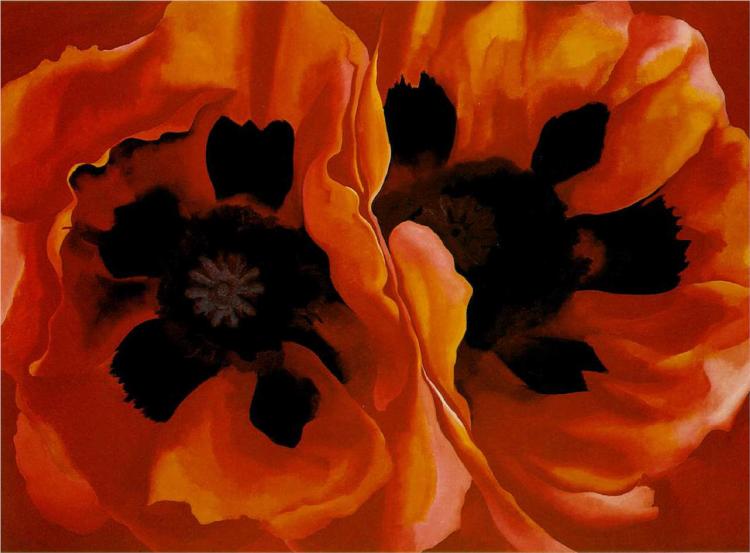
“Oriental Poppies”
Georgia O’Keefe (1887 – 1986)
.

And so. . . this morning I was sipping coffee, enjoying the morning sunrise above the whispering pines — and there they were: magnificent poppies that a transplanted busy New Yorker not only noticed, but celebrated. A childhood amazement returned, a connection was made with Taos and its most famous artist, and a remembrance was triggered of a New Mexican poet, Santa Fe’s May Sarton [Eleanore Marie Sarton], who once wrote:
“Everything that slows us down and forces patience, everything that sets us back into the slow circles of nature, is a help. Gardening is an instrument of grace.”
.
.
This weekend, extreme skiers and boarders from around the Southwest will descend on the rugged slopes and ridges of Taos Ski Valley for the annual Ben Myers Ridge-a-Thon.
Now in its 16th year, this grueling event attracts winter athletes — including former Governor Gary Johnson — who compete in an intense two-day skiing / boarding marathon. The event supports the Emergency Medicines Fund of the Taos Community Foundation.
This year The Blonde Bear Tavern will provide the food for the event’s awards party and celebration.
.
The Event
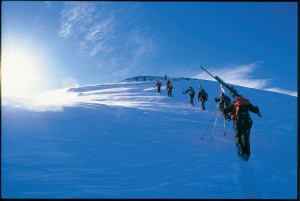
Singles or two-man teams hike and ski the extreme terrain and ridges of Taos Ski Valley non-stop for five hours. The object is to ski as many runs as possible within the time allotted. The competition ends at 2:00 pm, at which time participants may choose to hike and ski Kachina Peak, which will count as three bonus runs.
.
Taos Community Foundation’s Emergency Medicines Fund
The Fund provides vouchers for the purchase of prescription medications at wholesale cost from local pharmacies. The result is free prescriptions to eligible individuals. The Fund is an emergency alternative to more long-term assistance. Emergency Medicines supports local nonprofit organizations within Taos and western Colfax counties that are currently engaged in emergency service activities and provide assistance to undeserved individuals.
.
Ben Myers

Ben Myers was a well-known local extreme skier who died at the age of 26 of a rare cancer. His friends organized the Ridge-a-Thon in 1997 to collect money to pay his medical expenses. Today, the event helps others in similar situations.
Ben’s legacy lives on — not only his enthusiasm for skiing and Taos Ski Valley — but through this important yearly event that allows us all to help our friends and neighbors.
.
.
.
How You Can Help
Participants are currently soliciting donations, usually a set dollar amount for each run accomplished during the two days. I’m sponsoring our own Kent Forté, who is participating for the sixth year. Last year he completed 38 runs in the two days!
If you’re not familiar with a participant, please consider donating to this very worthy cause by visiting the Taos Community Foundation website.
Here’s a terrific video, which highlights Ben Myers, his dedicated friends and family, and the Ridge-A-Thon. It also shows some beautiful shots of Taos Ski Valley:
http://video.google.com/videoplay?docid=4011097246948254747&hl=en
.
.
.
I am constantly asked the question, “How do I improve my wine knowledge?” To which I always respond, “Keep drinking!” There’s no better way to familiarize yourself with wines than a wine tasting. It’s a great way to experience new vintages of your favorites, and to explore other varietals and regions around the world.
This week the Taos Winter Wine Festival will provide you such an opportunity. There are several seminars and dinners scheduled, along with two major tastings:
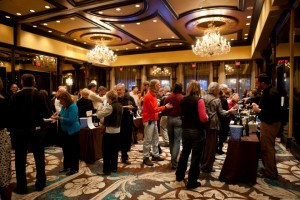 The Reserve Tasting will be held at the elegant El Monte Sagrado Resort, with a dozen of Taos’ best restaurants serving signature appetizers alongside tastes of reserve wine from owners and winemakers from 30 participating wineries. This Opening Night Reserve Tasting also features a silent auction of wine to benefit the Taos High School Culinary Arts Program.
The Reserve Tasting will be held at the elegant El Monte Sagrado Resort, with a dozen of Taos’ best restaurants serving signature appetizers alongside tastes of reserve wine from owners and winemakers from 30 participating wineries. This Opening Night Reserve Tasting also features a silent auction of wine to benefit the Taos High School Culinary Arts Program.
The Grand Tasting will be held right here in Taos Ski Valley, and will feature more than 155 different wines from 30 participating wineries — and tastes from a dozen of Taos and Taos Ski Valley’s finest restaurants, including The Blonde Bear Tavern. A silent auction of rare wines benefits the Taos Community Foundation.
 For more information and tickets, visit the Taos Winter Wine Festival website. Please stop by our booth to say hello — and after the event, why not come to The Blonde Bear Tavern for dinner and a little more wine?
For more information and tickets, visit the Taos Winter Wine Festival website. Please stop by our booth to say hello — and after the event, why not come to The Blonde Bear Tavern for dinner and a little more wine?
.
The Virtual Group of Italian Chefs celebrates its 5th Annual International Day of Italian Cuisines today as hundreds of chefs in over 40 countries around the world prepare and serve Ossobuco in Gremolata using an authentic recipe.

The Blonde Bear Tavern is joining the celebration, and you can, too. Learn the history of this centuries-old iconic dish, along with an in-depth look at the optimal ingredients and their correct proportion, as we reveal our famed recipe here.
.
.
.
Italians are masters of braising meats, and ossobuco is a perfect example. Take a relatively cheap cut of meat with lots of connective tissue, Braise it until the tough tissues melt, coating the meat fibers, rendering them soft and silky. As with Brasato, the meat will develop a velvety texture and delicious, earthy flavor, but with the added luxury of unctuous bone marrow.
Ossobuco is a centuries-old Lombard recipe of cross-cut veal shanks braised with vegetables, white wine, and broth. It is typically garnished with gremolata, a combination of lemon zest, parsley, and garlic. The most traditional accompaniments to the dish are risotto alla milanese, polenta, or mashed potatoes.
The dish is famous world-wide, and its recipe has been published extensively outside of Italy. It was featured in Henri-Paul Pellaprat’s famous L’Art Culinaire Moderne, published in France in 1935, and the British Italian Food, by Elizabeth David, first published in 1954. The dish has become a part of the French home cooking tradition, known as ossobucco à la milanaise (with added butter (!)
Every January 17th — for the last five years — the Virtual Group of Italian Chefs (GVCI) promotes one authentic Italian recipe on its International Day of Italian Cuisines (IDIC). We were honored to participate the last two years with a couple of Bellavitae signature dishes: Tagliatelle al Ragù Bolognese, and Pesto Genovese. The previous years featured Pasta alla Carbonara and Risotto alla Milanese.
The International Day of Italian Cuisines is born from a mission, as explained by Rosario Scarpato, GVCI Honorary President and last year’s IDIC Director:
“We certainly aim at educating worldwide consumers, but more than anything else, we want to protect their right to get what they pay for when going to eateries labeled as ‘Italian’; that is, authentic and quality Italian cuisine.”
So in celebratory spirit we participate again this year, right here at The Blonde Bear Tavern. Ossobuco is a perfect entree after skiing all day. Come join us this Tuesday, January 17th, for our preparation of ossobuco.
Lombardy – Birthplace of Ossobuco

.
Ossobuco traces its beginnings to Lombardy (“Lombardia” in Italian), and many believe to Milan, although there is some controversy about that. Lombardy is a large region in the north of Italy. The river Po forms a natural boundary in the south, the Alps to the north, with Lakes Garda on the east and Maggiore and Como on the West.
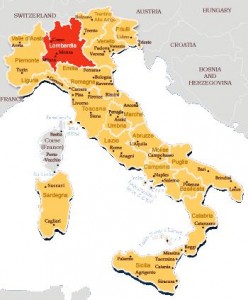
The regional cuisine of Lombardy is based upon ingredients like maize, rice, beef, pork, butter, and lard. Despite being a form of Italian cuisine, Lombard food tends to have little in common with Central or Southern Italian dishes, in many cases lacking the presence of tomato and olive oil, being more meat-based and buttery. In many ways, Lombard cuisine has much in common with that of Austria and much of central Europe in general.
But as Italian cuisine, Lombard food is full of variety and every city and part of the region offers its own specialties. A characteristic Lombard dish is risotto, most famously risotto alla milanese (which is made with saffron), with rice-based food being highly common throughout the region. Similar to risotto, maize-based dishes such as polenta are also common. Other famous Lombard dishes include cotoletta, cassoeula, and of course ossobuco. The region also offers several delicacies and desserts, including mostarda and panettone. Regional cheeses include Robiola, Crescenza, Taleggio, Gorgonzola and Grana Padano.
.
What to drink with Ossobuco
Which wines pair well with Ossobuco? Ask the expert, Luca Gardini, named the world’s best sommelier last year. His recommendations are here.
.
The History of Ossobuco
The word ossobuco (“oss bus” in Milanese dialect) means “bone with a hole” (osso bone, buco hole), a reference to the marrow hole at the center of the cross-cut veal shank.
Milan claims to be the birth city of ossobuco and in 2007, the City Council declared it as part of the De.Co. (Denominazioni Comunali or community denominations), which is an official public acknowledgement that a dish belongs to a certain territory.
The use of marrow bones and veal shanks was common in Middle Age Italian cuisine, but there is no evidence of the presence of ossobuco as a dish at that time. The recipe is believed to have first appeared in Pellegrino Artusi’s cookbook La Scienza in Cucina e l’Arte di Mangiar Bene (The Science in the Kitchen and the Art of Eating Well), the first collection of Italian national cuisine ever published. The book celebrates both home cooking and well-known dishes from all over Italy. These dishes were well-established, indicating the dish had been around for decades, most likely originating in one of the region’s osterie or trattorie.
The Ingredients (for six servings)
For the Ossobuco:
Preparing Ossobuco
Preheat the oven to 325°F and adjust the rack to the lower middle portion, so the Dutch oven will rest in the middle of the oven.
.
.
Related:
.
Further Reading:
Ossobuco, the perfect winter dish, most satisfying after a vigorous run down the mountain. Too tired to make it yourself? Join us and hundreds of other chefs around the world on January 17th. Enjoy this famous dish, evolved over centuries, right here at The Blonde Bear Tavern.
.

.
The week between Christmas and New Years is busy for any ski resort, and Taos Ski Valley is no exception. But this year, the planets aligned and we were blessed with arguably the best snow in North America. Add to that perfect New Mexico weather. We prayed the skiers would come, and boy did they.
An avalanche maybe? What exuberance! Folks from all over the world converged on our village to enjoy phenomenal skiing, a happy holiday, and of course good food and wine.
One of the week’s highlights is the annual torch light parade, where skiers carrying red flares race down the mountain, followed by colorful fireworks – all against the magnificent canvas of pure white snow.
Here’s a long-exposure photograph that captures the scene:
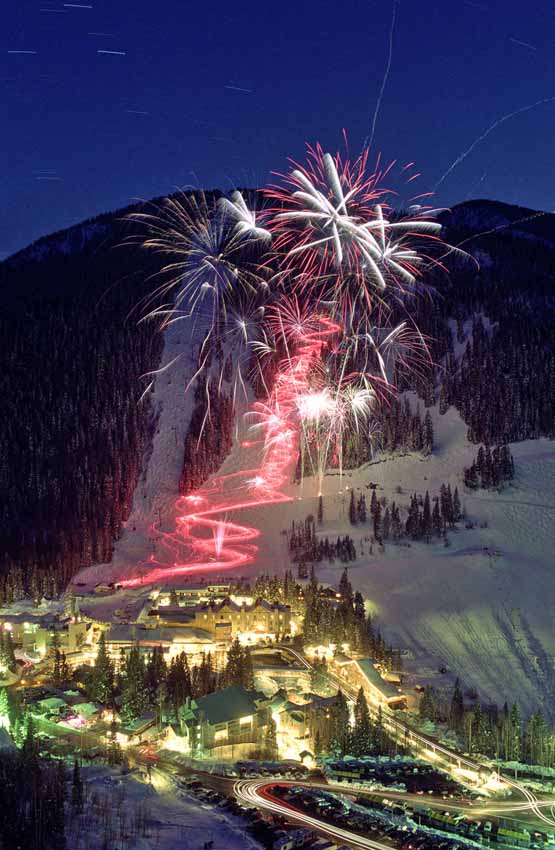
.
And here’s a video of the event:
.
Yeah, we’re a little pooped, but what a way to ring in the new year!
So from all of us at The Blonde Bear Tavern:
.
.
.
Buon Anno!
.
Theme: Food Express WordPress Food Theme is developed by Template Express.
Proudly powered by WordPress